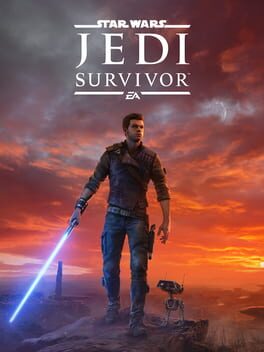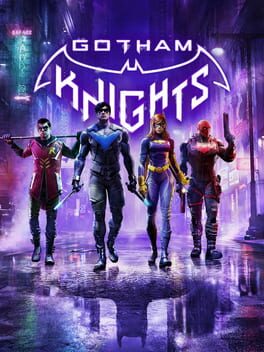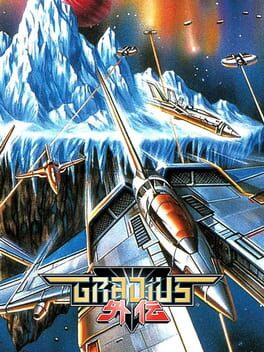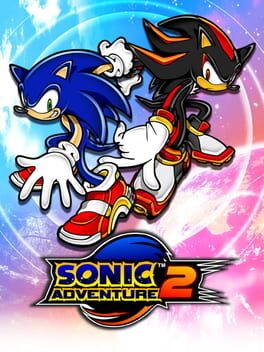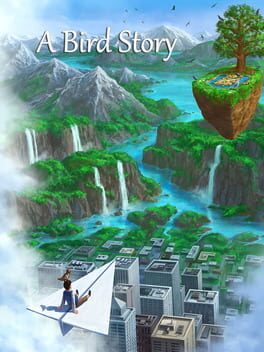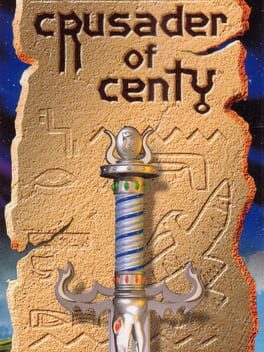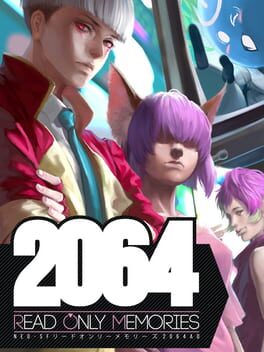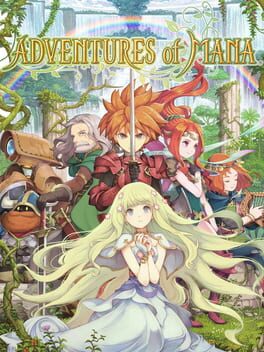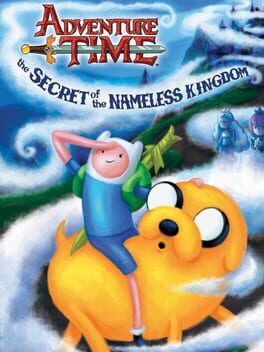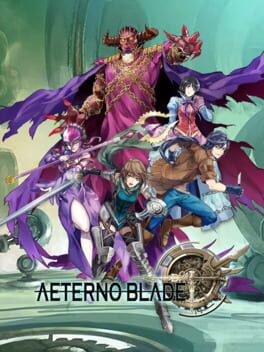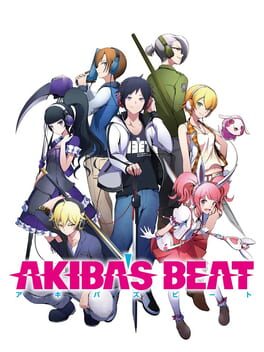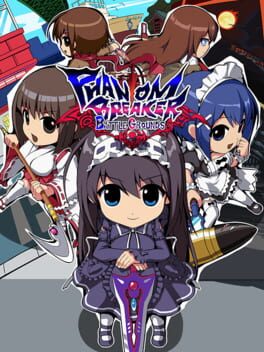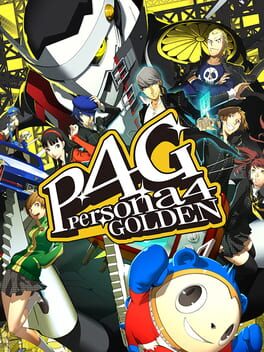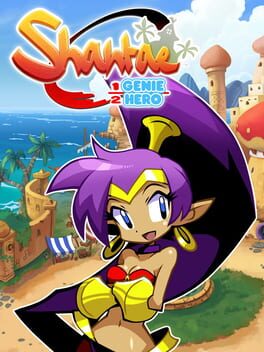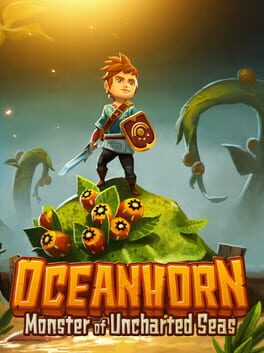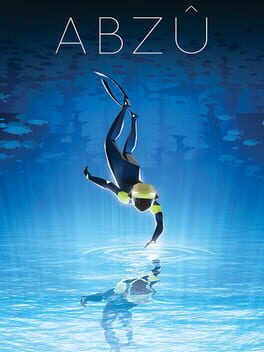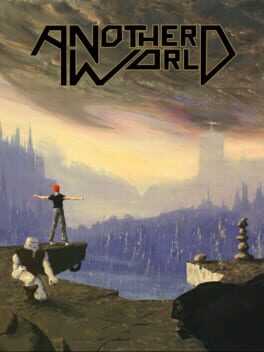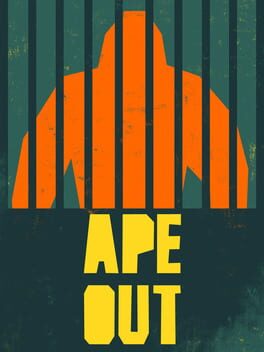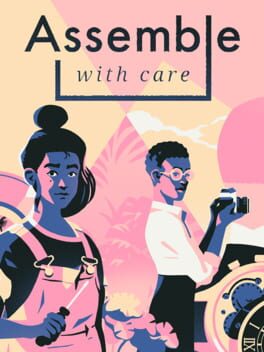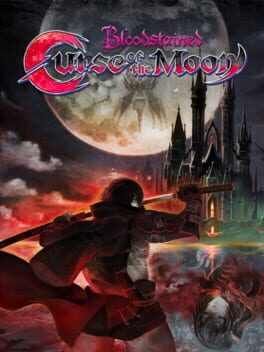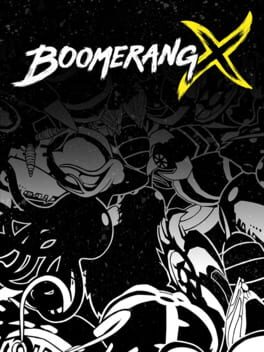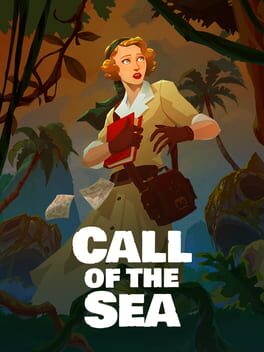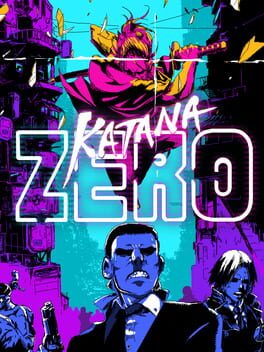Guu
281 reviews liked by Guu
Uma sequencia perfeita e um dos melhores jogos q eu ja joguei
Tudo é melhor em relação ao anterior apesar de isso ser obrigação, mas não é só melhor como adiciona diversos novos elementos na gameplay, tira a linearidade e adiciona um mundo semi aberto
Isso da uma aula pra Disney sobre tudo de Star Wars como uma historia incrivel com personagens incríveis e um desfecho q pode mudar muito a lore pro futuro da franquia
Pra mim se posso colocar um defeito é sobre a perfomance de Kobah q mesmo hj ainda da umas pequenas quedas mas sendo sincero foram bem poucos e não considero um defeito
Jogaço q recomendo a todos q gostem de Star Wars ou até quem não gosta, só joga logo agora q ta no Gamepass.
Tudo é melhor em relação ao anterior apesar de isso ser obrigação, mas não é só melhor como adiciona diversos novos elementos na gameplay, tira a linearidade e adiciona um mundo semi aberto
Isso da uma aula pra Disney sobre tudo de Star Wars como uma historia incrivel com personagens incríveis e um desfecho q pode mudar muito a lore pro futuro da franquia
Pra mim se posso colocar um defeito é sobre a perfomance de Kobah q mesmo hj ainda da umas pequenas quedas mas sendo sincero foram bem poucos e não considero um defeito
Jogaço q recomendo a todos q gostem de Star Wars ou até quem não gosta, só joga logo agora q ta no Gamepass.
Alan Wake II
2023
Gosto muito do 1° Alan Wake e fui bem animado para esse depois de ver tantos elogios.
-O jogo está belíssimo, e a mescla com as partes com atores são muito boas.
-A nova protagonista, Saga ,é bem sem graça, o principal ponto da personagem é o mistério com relação a sua família e principalmente a filha, e isso se arrasta por toda a campanha. No final essa questão ainda fica no ar, e eu já nem me importava mais.
-Falando nela, o Mind Place foi um negocio completamente desperdiçado.
-O lance dos perfis é uma muleta total, é utilizado para a Saga chegar a conclusões e respostas sem base em nada ao invés do enredo fazer ela chegar a essas deduções de forma natural. O jogo da uma explicação pra isso , mais pro final, mas é totalmente jogado, e sem aprofundamento.
-O quadro de pistas parece interessante no inicio mas depois você percebe que é uma perda de tempo, só serve
para, de uma forma bem lenta, você chegar a uma conclusão que você já sabia.
-Jump Scare, por algum motivo encheram o jogo de jump scare aleatórios, um recurso pra deixar o jogo mais "assustador" e dar susto no jogador de forma artificial.
-O combate ficou muito travadão, talvez seja tecnicamente melhor, mas prefiro o do primeiro, que também te dava sustos e te deixava tenso, mesmo sendo mais "ação".
-Com relação a historia geral, quiseram deixar a historia mais complexa mas acabou ficando só confusa.
-Os diálogos 90% do tempo não são claros, tudo é dito em forma de enigma ou de metáfora.
-No jogo anterior havia umas questões meio abstratas também, mas havia claros objetivos concretos que deviam ser alcançados que deixavam o ritmo do jogo melhor e mais compreensível. Nesse segundo é tudo muito enrolado, principalmente nas partes no mundo escuro que você anda pra lá e pra cá fazendo coisas aleatórias, sem sentir que o enredo está avançando. A impressão que ficou pra mim, é que esse jogo terminou e nada aconteceu, que estamos no mesmo ponto em que o primeiro jogo terminou.
-O jogo está belíssimo, e a mescla com as partes com atores são muito boas.
-A nova protagonista, Saga ,é bem sem graça, o principal ponto da personagem é o mistério com relação a sua família e principalmente a filha, e isso se arrasta por toda a campanha. No final essa questão ainda fica no ar, e eu já nem me importava mais.
-Falando nela, o Mind Place foi um negocio completamente desperdiçado.
-O lance dos perfis é uma muleta total, é utilizado para a Saga chegar a conclusões e respostas sem base em nada ao invés do enredo fazer ela chegar a essas deduções de forma natural. O jogo da uma explicação pra isso , mais pro final, mas é totalmente jogado, e sem aprofundamento.
-O quadro de pistas parece interessante no inicio mas depois você percebe que é uma perda de tempo, só serve
para, de uma forma bem lenta, você chegar a uma conclusão que você já sabia.
-Jump Scare, por algum motivo encheram o jogo de jump scare aleatórios, um recurso pra deixar o jogo mais "assustador" e dar susto no jogador de forma artificial.
-O combate ficou muito travadão, talvez seja tecnicamente melhor, mas prefiro o do primeiro, que também te dava sustos e te deixava tenso, mesmo sendo mais "ação".
-Com relação a historia geral, quiseram deixar a historia mais complexa mas acabou ficando só confusa.
-Os diálogos 90% do tempo não são claros, tudo é dito em forma de enigma ou de metáfora.
-No jogo anterior havia umas questões meio abstratas também, mas havia claros objetivos concretos que deviam ser alcançados que deixavam o ritmo do jogo melhor e mais compreensível. Nesse segundo é tudo muito enrolado, principalmente nas partes no mundo escuro que você anda pra lá e pra cá fazendo coisas aleatórias, sem sentir que o enredo está avançando. A impressão que ficou pra mim, é que esse jogo terminou e nada aconteceu, que estamos no mesmo ponto em que o primeiro jogo terminou.
Gotham Knights
2022
-O jogo vale a pena só ser você tiver alguém pra jogar junto.
-Tem varias skins legais com possibilidade de mudar os seus acessórios.
-As missões de "Dossiê" são as mais legais e trazem algo diferente.
-A historia não é grande coisa.
-O mundo aberto é sem graça e com poucas coisas interessantes para fazer, e que acabam se tornando repetitivas.
-Tem varias skins legais com possibilidade de mudar os seus acessórios.
-As missões de "Dossiê" são as mais legais e trazem algo diferente.
-A historia não é grande coisa.
-O mundo aberto é sem graça e com poucas coisas interessantes para fazer, e que acabam se tornando repetitivas.
This review contains spoilers
-O combate que já era bom no jogo anterior, está melhor ainda nesse, principalmente pela possibilidade de se movimentar durante o combate.
-O mapa do Havaí é bonito e traz um clima diferente em relação aos anteriores.
-Achei as musicas sofreram uma queda em relação ao YLD.
-As lembranças dos outros jogos com Kiryu são bem legais.
-Agora o enredo e o ritmo são os meus principais problemas com esse jogo.
-Até a metade até que flui bem, mas depois o negocio começa a patinar.
-Acho que teria sido muito melhor se tivessem focado só no Havaí, Palekana e a Akane, mas ficaram misturando um monte de coisa e nem tudo tem atenção que merece.
-Teve um jogo inteiro construindo a relação entre Hanawa e Kiryu, e aqui ele tem uma morte fraca e Kiryu parece nem se importar com o acontecido.
-A Akane e o Ichiban, que é o que dá inicio a tudo, tem um relacionamento mal desenvolvido e não tem uma conclusão satisfatória.
-E essa busca por ela se arrastou demais, ficavam andando em círculos, seguindo pistas que não davam em nada por muito tempo.
-Ficam forçando esse romance entre Ichiban e Saeko, personagens que não tem química juntos, que só serve para ficar pisando na cabeça do Ichiban .
-Entendo que o lance do Ichiban é sempre ver o bom nas pessoas, mas ele com o Eiji no final já foi demais, nem a explicação que o Ichiban deu foi plausível.
-É revelado que o Ebina é meio irmão do Ichiban e isso não é explorado mais a fundo, o Ichiban nem se encontra com ele depois disso. O que faria mais sentido do que deixar para o Kiryu enfrentar ele.
-Não gosto deles mais uma vez colocarem Daigo, Saejima e Majima juntos. São personagens muito bons por si sós, mas que parece que estão aqui só pro fan service então botão tudo em um pacote só para poder resolver isso logo, o que acaba deixando eles sem personalidade própria.
-Acho que teria sido muito bom se tivessem colocado alguns dos conhecidos do Kiryu como membros do grupo para dar uma equilibrada, pq ele só fica andando com os amigos do Ichiban.
-Também acho que podia ter mais interações interessantes entre Kiyu e Ichiban.
-O mapa do Havaí é bonito e traz um clima diferente em relação aos anteriores.
-Achei as musicas sofreram uma queda em relação ao YLD.
-As lembranças dos outros jogos com Kiryu são bem legais.
-Agora o enredo e o ritmo são os meus principais problemas com esse jogo.
-Até a metade até que flui bem, mas depois o negocio começa a patinar.
-Acho que teria sido muito melhor se tivessem focado só no Havaí, Palekana e a Akane, mas ficaram misturando um monte de coisa e nem tudo tem atenção que merece.
-Teve um jogo inteiro construindo a relação entre Hanawa e Kiryu, e aqui ele tem uma morte fraca e Kiryu parece nem se importar com o acontecido.
-A Akane e o Ichiban, que é o que dá inicio a tudo, tem um relacionamento mal desenvolvido e não tem uma conclusão satisfatória.
-E essa busca por ela se arrastou demais, ficavam andando em círculos, seguindo pistas que não davam em nada por muito tempo.
-Ficam forçando esse romance entre Ichiban e Saeko, personagens que não tem química juntos, que só serve para ficar pisando na cabeça do Ichiban .
-Entendo que o lance do Ichiban é sempre ver o bom nas pessoas, mas ele com o Eiji no final já foi demais, nem a explicação que o Ichiban deu foi plausível.
-É revelado que o Ebina é meio irmão do Ichiban e isso não é explorado mais a fundo, o Ichiban nem se encontra com ele depois disso. O que faria mais sentido do que deixar para o Kiryu enfrentar ele.
-Não gosto deles mais uma vez colocarem Daigo, Saejima e Majima juntos. São personagens muito bons por si sós, mas que parece que estão aqui só pro fan service então botão tudo em um pacote só para poder resolver isso logo, o que acaba deixando eles sem personalidade própria.
-Acho que teria sido muito bom se tivessem colocado alguns dos conhecidos do Kiryu como membros do grupo para dar uma equilibrada, pq ele só fica andando com os amigos do Ichiban.
-Também acho que podia ter mais interações interessantes entre Kiyu e Ichiban.
Player Non Player
2024
Player Non Player is one of those pleasant surprises I keep searching for. Despite the amateurish production values, there's a lot of heart and introspection. I was personally touched by a lot of the themes brought up by the various characters who follow a familiar structure of having a few unresolved issues tying them to the earth still.
The fear of death, loneliness, heartbreak, grief, body dysmorphia are all for the most part dealt in a very human way, on an island of stark contrasts, of photogrammetry asset store packs which nevertheless feel deliberate in their usage. The architecture and camera work during these character quests remain engrossing the whole way through.
But I think what elevates it is the surprising movement options for what could be dismissively labeled a walking simulator, with a hoverboard and super jump, there's a genuine appreciation and almost parody of videogame levels without being pretentious, there's a self awareness about it all that I appreciate. There's mario coins FFS. Even the way in which you interact with the world via your hand which stretches out to follow the camera in an octodad-esque manner when you press the left mouse button is used cleverly and amusingly.
It gets a recommendation from me.
The fear of death, loneliness, heartbreak, grief, body dysmorphia are all for the most part dealt in a very human way, on an island of stark contrasts, of photogrammetry asset store packs which nevertheless feel deliberate in their usage. The architecture and camera work during these character quests remain engrossing the whole way through.
But I think what elevates it is the surprising movement options for what could be dismissively labeled a walking simulator, with a hoverboard and super jump, there's a genuine appreciation and almost parody of videogame levels without being pretentious, there's a self awareness about it all that I appreciate. There's mario coins FFS. Even the way in which you interact with the world via your hand which stretches out to follow the camera in an octodad-esque manner when you press the left mouse button is used cleverly and amusingly.
It gets a recommendation from me.
Gradius Gaiden
1997
After posting three big reviews on some of the games that I played recently, I want to fill out one more before I continue working on my Crusaders Quest review. Like the two Dark Witch ones that I’ve done, this one revisits another series that I’m well into: Gradius! As you can se from my profile, Gradius is one of the 5 most favorited games that I’m associated with, and there’s a good reason for it. The customization for the infamous bar is fantastic level design, and the replayabillity gets extended by a huge marjin. Just want to play it for the speed? Using Ripple instead of Laster? (or vice versa?) Gradius has a bunch of potential, and mostly every entry is great. For this review, I’m going to be discussing about Gradius Gaiden, the 1997 entry of Gradius released on Playstation in Japan only (although it did see a brief release of the PSP Gradius collection but it’s a worsened port of it), and it has got to be one of the best entries Konami has cooked with this series. Not only taking everything that defined the series, but it turns some aspects into original ideas, to make it seem like the true Gradius IV. The one released after it also called Gradius IV I personally believe that it’s the worst mainline Gradius one to date. I mean, after perfecting the customization options seen in Gaiden, they’d go BACK to the original way of having a set pattern from Gradius II. And the graphics makes me believe that Gradius had the rougher transition to 3D and puts Sonic out of the spotlight. I mean, why? “I remember it being on OK space shooter,” my ass. The graphics look awful, and Gofer looks like a GOLF BALL!!!!!!!!! I almost want to make another review on this game, but I do want to continue working on CQ, so this one will be relatively long but also relatively quick. With that out of the way…
The (anti)fandom says that this game is the first one to incorporate 3D graphics, but I don’t see that anywhere in the game at all. I guess the 3D Graphics is the well done detailed sprites? I seriously can’t find where the 3D comes from. If this game has 3D Graphics, please tell me right away. But for the story, it’s pretty much that it’s Set after the third Bacterion war, the planet Gradius faces a new threat from the Black Nebula, leading to a mission where four hyper-space fighters are sent to confront the enemy. I assume the 3rd Bacterian war is the one featured from Gradius III for this one cause this technically is the game that came right after that one. The ships that it talks about is the Vic Viper, a staple, Lord Biritish, also a staple originally featured in Salamander, and then two new ones to the series: Jade Knight, and Falchion Beta. The gameplay for this game is of course, very similar to the original Gradius, but for Gaiden????
- Missile, Double and Laser weapons can be additionally powered up one level (but will reset once the player dies)
- There are two more shield types: Guard and Limit. Guard allows you to be immune to physical obstacle collisions, and limit makes you invulnerable to everything. And this is overpowering. Why is it overpowered?
- The Slot order can be rearranged however you like. Shield can be first, option can be second, speed can be third, etc. It’s one of the best things that the game has ever introduced, and it’s funny that they have absolutely never gotten though this concept in any of the other entries other than this one. They should’ve made this a golden standard. ‘
- A new level select and free play mode (unlimited credits) that can be gotten by beating the game and having at least 10 hours of in-game time.
This should be everything new that this game has, and what’s exclusive to this game too. Gaiden has got to be one of the best Gadius of all time for the graphics, action, and activity. Remember Gradius II? People think that’s the best game in the series because it improved everything that the original game has done, especially in terms of difficulty. It also even improved Salamander with all of it’s enemies and bosses! Despite being a spinoff, Konami inserts the Salamander series as a mainline game for how much the story relates to the Bacterians and such. It also includes the Vic Viper. Gradius II is also known for how active the game is when doing along with the player. Gaiden takes that and cranks it up a notch with the male (or female!!! That’s also new to Gradius) announcer saying new dialogue everywhere like “Watch your back!” or “Crush all of them!” They have done a great job with the dialogue for this game, and even the enemies also have some of the spotlight. The moai boss, the final boss, and every other boss that speaks. Another thing that goes great with their efforts is the music, and oh BOY do I mean that. The soundtrack is AMAZING!!! Every song even the options is just as heroic and action-packed as what a Gradius game should be! I don't know who the composer is but they need to be ranked as the best composer in all of Konami. The Air battle, SNOWFIELD, and all the other songs that I know are all great. Although this is what I have to say about Gradius Gaiden. A perfected Gradius Game that has to be the best one that they’ve created.
Now let me work on my Crusaders Quest review. This should be the end of revisiting some of my reviews. This one was great, and so as the other ones that I've done.
Sonic Adventure 2
2001
Sonic Adventure 1 Review
I recently went on a nostalgia trip by experiencing the original version of Sonic Adventure for the first time, after only having played the DX version on the GameCube. Once I finished it, I decided to continue that nostalgia trip by going ahead and playing through the Dreamcast version of its sequel as well. I was quite fond of both games as a kid, but at some point, I got the idea in my head that the first Adventure was better than the second. After coming back to both games, I no longer believe that to be true. Both games have problems, but Sonic Adventure 2 is a far more consistent and polished experience. It definitely has some low points, but it’s still a solid improvement over its predecessor that trims a lot of its fat.
After Dr. Eggman looks into his family history, he discovers a top secret project that was worked on by his grandfather, Dr. Gerald Robotnik. He infiltrates a military base where this project was being stored and uncovers Shadow the Hedgehog: The Ultimate Lifeform. Shadow promises Eggman a wish and brings Eggman to the Space Colony ARK, where he shows off the Eclipse Canon, a weapon of mass destruction powered by the seven Chaos Emeralds. Meanwhile, the military mistakes Sonic for Shadow, and their forces set out to capture him, all the while completely unaware they’re chasing after the wrong hedgehog. Sonic, Tails and Knuckles once again band together to take down Eggman, Shadow, and the mysterious Rouge the Bat and clear Sonic’s name before Eggman and his allies manage to obtain all of the Chaos Emeralds and power up the Eclipse Canon.
Instead of each playable character having their own unique campaign to play through, the main story of Sonic Adventure 2 is told through two campaigns that each star three characters. There’s Hero, which stars the classic trio of Sonic, Tails and Knuckles, and Dark, which stars Dr. Eggman and newcomers Shadow the Hedgehog and Rouge the Bat. One character from each campaign share a different style of gameplay that comes from the first Adventure. This time around each character has their own unique stages, unlike in the previous game, where you generally played through chopped up versions of Sonic’s stages. For the most part, each character having their own unique stage is to Sonic Adventure 2’s benefit, and while some stages do have flaws that I’ll be getting into, at the very least this keeps the game from feeling as repetitive as Sonic Adventure did with its stages.
Sonic and Shadow’s stages feature the same speed focused platforming gameplay as Sonic’s stages from Adventure. They’re no longer composed of multiple sections, but the stages themselves are still comparable in length to the ones from the previous game. These stages are all fantastic, and once again, easily the best part of the game in general. They’re all laser focused on bringing out the best of these characters’ gameplay. I also had significantly less issues with the camera this time around, which was one of my biggest hang ups with the first Adventure. There were definitely still times where the camera would freak out or not cooperate, but not nearly as much as in the previous game.
Tails and Eggman’s gameplay is a more refined version of E-102 Gamma’s gameplay from the previous game. Tails and Eggman each pilot a small mech, and they run and gun throughout their stages with the same auto-homing shots as Gamma. This is where each character having their own unique stage really shines, as Tails and Eggman’s stages offer unique platforming challenges built around their moveset. Their stages are a lot longer compared to Gamma’s as well, giving a chance for their gameplay to actually breathe. My biggest complaint with Gamma’s gameplay and stages was that they all felt rather braindead. Since your projectiles automatically homed in on whatever you target, there wasn’t really anything stopping you from just targeting everything without any second thought. Tails and Eggman’s gameplay isn’t quite as trivial as Gamma’s was. While it’s still rather easy for the most part, there are actually a few enemies that require you to time your shots, as well as a couple of stages that will actually punish you for mindlessly targeting and shooting everything with environmental hazards that can cause you to take damage or die if you end up shooting them, which is a great way to force you to pay attention to what you’re shooting.
Finally, Knuckles and Rouge share Knuckles’ exploration-based gameplay from Adventure , where you search through stages for pieces of the Master Emerald. Unfortunately, despite also being given unique stages, Knuckles and Rouge’s gameplay isn’t a direct upgrade from Adventure, and it’s during their stages where a lot of my problems with the game stem from. For starters, the Emerald Radar, which is a tool that would beep at increasingly faster speeds the closer you get to an Emerald piece, was changed so that it only detects one Emerald piece at a time, whereas in Adventure, it could detect all three pieces at once. I have a theory about why this was done: Knuckles stages in Adventure tended to be rather small in terms of scale, and having the radar being able to detect all three Emerald pieces at once made it easy to find them rather quickly. In Adventure 2 however, all of Knuckles’ (and Rogue’s) stages are a lot larger compared to Knuckles’ stages in the previous game, so it makes hunting down the Emerald pieces one at a time take a lot longer. This problem gets worse with each subsequent stage, as they get larger and larger, coming to a head with the stages Meteor Herd and Mad Space, the final stages for Knuckles and Rouge respectively. These stages are so large that it can take up to 15 minutes to beat them if you’re unlucky with where the Emerald pieces are placed. Also, the one key difference between the Dreamcast version and the GameCube version of Sonic Adventure 2 that would make me recommend the latter over the former is that if Knuckles or Rouge walk or climb over a surface where an Emerald piece is buried, an exclamation point will appear above their head, letting you know that the piece is buried in that specific spot. This exclamation point doesn’t appear in the Dreamcast version, which made trying to find buried Emerald pieces a much bigger headache.
One aspect of Sonic Adventure that I completely forgot to talk about in my review for it was its various hub worlds that you need to travel through in-between stages. The main reason why I forgot to mention them was because of how little they really added to the game. They felt like they were just there for the sake of being there. They were rather small, they weren’t very interesting to explore, and there wasn’t much you could do in them besides just going into one of the characters’ levels or the Chao Garden. You could find some optional power ups for characters, which admittedly were kind of useful, but also weren’t necessary to finish the game and didn’t really enrich the experience that much further. As such, it’s no surprise that they were cut from Sonic Adventure 2, which was truly for the best. Instead, each campaign simply has one character’s stage follow another, and you can travel to the Chao Garden by finding a Chao Key item in a stage.
The story is a bit more straightforward and less ambitious than Sonic Adventure’s, but I think that was for the best, as it flows a lot better. It’s a Sonic game, so the writing isn’t some airtight masterwork of fiction, but it’s a decent enough story with some high stakes and thrilling moments. There are some aspects to the story that, even as a kid, I thought were questionable. In particular, the fact that anyone could confuse Sonic for Shadow and vice versa when they look nothing alike always confused me, even back then. Also Amy Rose appears as a non-playable character in the story, and her presence in general really confuses me. She frequently just… appears in locations with little to no explanation. It feels like she was meant to have a larger role in the game that got cut down heavily. The voice acting sounds a lot better this time around. Some characters do still sound a bit stiff like Tails and Rouge, but everyone else sounds like they have a lot more energy and are actually trying with their performances. Though Deem Bristow’s Eggman once again steals the show, I really gotta say, I feel like Ryan Drummond’s Sonic in particular has significantly improved. He sounds way more lively than before, and he does a better job capturing Sonic’s wit and attitude.
The music continues the Sonic series’ tradition of being fantastic. Something that I noticed during this playthrough is that each character has a specific type of music that plays during their stages. Sonic’s stages have fast paced punk rock tracks, Tails has upbeat rock that occasionally features some synthesizers, Knuckles has old school hip hop, Shadow features very bass heavy techno with distorted vocals, Eggman has heavy rock tracks that feature a lot of synthesizers, and Rouge has upbeat jazz tracks very reminiscent of spy films like the 007 movies, but with a lot of sensual sounding female background vocals. It’s a really excellent touch, and I very much dig how each stage’s song feels like it was tailored not just for the stage, but for the characters themselves. Some of my favorite tracks include Green Forest, Pumpkin Hill, White Jungle, and Cosmic Wall. (Yes I like City Escape too, I just thought claiming it as a favorite would be disingenuous and boring).
One of the game’s most notable issues is how truly awful its audio mixing and sound design is. Sound effects are deafeningly loud, in particular Tails and Eggman’s targeting laser as well as the Emerald Radar in Knuckles and Rouge’s stages. They both beep obnoxiously loudly. In stages where the Military are pursuing you like in Metal Harbor, Weapons Bed, or Mission Street, there will be this airplane engine sound effect that is also just so ridiculously loud it drowns out all of the other sounds and music that plays on the stage. Meanwhile the dialogue is too quiet, and characters frequently talk over each other. This can lead to some funny exchanges, such as during the cutscene where Sonic and Shadow battle one another on Prison Island, which for whatever reason has always tickled my funny bone even when I was little. The sound design doesn’t make the game unplayable by any means, but it’s very noticeable, jarring and annoying.
I was surprised to find that I still dig Sonic Adventure 2, at least more than I expected to after revisiting Sonic Adventure just before. There was a clear effort to improve upon Sonic Adventure, and I really respect that. I do think they did a rather decent job doing so for the most part. The Knuckles and Rouge stages are definitely a drag, the audio mixing is rather horrendous, and there are aspects of the story that can be a bit questionable, but the game as a whole still manages to be a pretty good time despite that, thanks to the excellent gameplay and level design of the other characters’ stages. At its best, Sonic Adventure 2 still manages to be hype even after all these years, and that’s not just the nostalgia talking.
I recently went on a nostalgia trip by experiencing the original version of Sonic Adventure for the first time, after only having played the DX version on the GameCube. Once I finished it, I decided to continue that nostalgia trip by going ahead and playing through the Dreamcast version of its sequel as well. I was quite fond of both games as a kid, but at some point, I got the idea in my head that the first Adventure was better than the second. After coming back to both games, I no longer believe that to be true. Both games have problems, but Sonic Adventure 2 is a far more consistent and polished experience. It definitely has some low points, but it’s still a solid improvement over its predecessor that trims a lot of its fat.
After Dr. Eggman looks into his family history, he discovers a top secret project that was worked on by his grandfather, Dr. Gerald Robotnik. He infiltrates a military base where this project was being stored and uncovers Shadow the Hedgehog: The Ultimate Lifeform. Shadow promises Eggman a wish and brings Eggman to the Space Colony ARK, where he shows off the Eclipse Canon, a weapon of mass destruction powered by the seven Chaos Emeralds. Meanwhile, the military mistakes Sonic for Shadow, and their forces set out to capture him, all the while completely unaware they’re chasing after the wrong hedgehog. Sonic, Tails and Knuckles once again band together to take down Eggman, Shadow, and the mysterious Rouge the Bat and clear Sonic’s name before Eggman and his allies manage to obtain all of the Chaos Emeralds and power up the Eclipse Canon.
Instead of each playable character having their own unique campaign to play through, the main story of Sonic Adventure 2 is told through two campaigns that each star three characters. There’s Hero, which stars the classic trio of Sonic, Tails and Knuckles, and Dark, which stars Dr. Eggman and newcomers Shadow the Hedgehog and Rouge the Bat. One character from each campaign share a different style of gameplay that comes from the first Adventure. This time around each character has their own unique stages, unlike in the previous game, where you generally played through chopped up versions of Sonic’s stages. For the most part, each character having their own unique stage is to Sonic Adventure 2’s benefit, and while some stages do have flaws that I’ll be getting into, at the very least this keeps the game from feeling as repetitive as Sonic Adventure did with its stages.
Sonic and Shadow’s stages feature the same speed focused platforming gameplay as Sonic’s stages from Adventure. They’re no longer composed of multiple sections, but the stages themselves are still comparable in length to the ones from the previous game. These stages are all fantastic, and once again, easily the best part of the game in general. They’re all laser focused on bringing out the best of these characters’ gameplay. I also had significantly less issues with the camera this time around, which was one of my biggest hang ups with the first Adventure. There were definitely still times where the camera would freak out or not cooperate, but not nearly as much as in the previous game.
Tails and Eggman’s gameplay is a more refined version of E-102 Gamma’s gameplay from the previous game. Tails and Eggman each pilot a small mech, and they run and gun throughout their stages with the same auto-homing shots as Gamma. This is where each character having their own unique stage really shines, as Tails and Eggman’s stages offer unique platforming challenges built around their moveset. Their stages are a lot longer compared to Gamma’s as well, giving a chance for their gameplay to actually breathe. My biggest complaint with Gamma’s gameplay and stages was that they all felt rather braindead. Since your projectiles automatically homed in on whatever you target, there wasn’t really anything stopping you from just targeting everything without any second thought. Tails and Eggman’s gameplay isn’t quite as trivial as Gamma’s was. While it’s still rather easy for the most part, there are actually a few enemies that require you to time your shots, as well as a couple of stages that will actually punish you for mindlessly targeting and shooting everything with environmental hazards that can cause you to take damage or die if you end up shooting them, which is a great way to force you to pay attention to what you’re shooting.
Finally, Knuckles and Rouge share Knuckles’ exploration-based gameplay from Adventure , where you search through stages for pieces of the Master Emerald. Unfortunately, despite also being given unique stages, Knuckles and Rouge’s gameplay isn’t a direct upgrade from Adventure, and it’s during their stages where a lot of my problems with the game stem from. For starters, the Emerald Radar, which is a tool that would beep at increasingly faster speeds the closer you get to an Emerald piece, was changed so that it only detects one Emerald piece at a time, whereas in Adventure, it could detect all three pieces at once. I have a theory about why this was done: Knuckles stages in Adventure tended to be rather small in terms of scale, and having the radar being able to detect all three Emerald pieces at once made it easy to find them rather quickly. In Adventure 2 however, all of Knuckles’ (and Rogue’s) stages are a lot larger compared to Knuckles’ stages in the previous game, so it makes hunting down the Emerald pieces one at a time take a lot longer. This problem gets worse with each subsequent stage, as they get larger and larger, coming to a head with the stages Meteor Herd and Mad Space, the final stages for Knuckles and Rouge respectively. These stages are so large that it can take up to 15 minutes to beat them if you’re unlucky with where the Emerald pieces are placed. Also, the one key difference between the Dreamcast version and the GameCube version of Sonic Adventure 2 that would make me recommend the latter over the former is that if Knuckles or Rouge walk or climb over a surface where an Emerald piece is buried, an exclamation point will appear above their head, letting you know that the piece is buried in that specific spot. This exclamation point doesn’t appear in the Dreamcast version, which made trying to find buried Emerald pieces a much bigger headache.
One aspect of Sonic Adventure that I completely forgot to talk about in my review for it was its various hub worlds that you need to travel through in-between stages. The main reason why I forgot to mention them was because of how little they really added to the game. They felt like they were just there for the sake of being there. They were rather small, they weren’t very interesting to explore, and there wasn’t much you could do in them besides just going into one of the characters’ levels or the Chao Garden. You could find some optional power ups for characters, which admittedly were kind of useful, but also weren’t necessary to finish the game and didn’t really enrich the experience that much further. As such, it’s no surprise that they were cut from Sonic Adventure 2, which was truly for the best. Instead, each campaign simply has one character’s stage follow another, and you can travel to the Chao Garden by finding a Chao Key item in a stage.
The story is a bit more straightforward and less ambitious than Sonic Adventure’s, but I think that was for the best, as it flows a lot better. It’s a Sonic game, so the writing isn’t some airtight masterwork of fiction, but it’s a decent enough story with some high stakes and thrilling moments. There are some aspects to the story that, even as a kid, I thought were questionable. In particular, the fact that anyone could confuse Sonic for Shadow and vice versa when they look nothing alike always confused me, even back then. Also Amy Rose appears as a non-playable character in the story, and her presence in general really confuses me. She frequently just… appears in locations with little to no explanation. It feels like she was meant to have a larger role in the game that got cut down heavily. The voice acting sounds a lot better this time around. Some characters do still sound a bit stiff like Tails and Rouge, but everyone else sounds like they have a lot more energy and are actually trying with their performances. Though Deem Bristow’s Eggman once again steals the show, I really gotta say, I feel like Ryan Drummond’s Sonic in particular has significantly improved. He sounds way more lively than before, and he does a better job capturing Sonic’s wit and attitude.
The music continues the Sonic series’ tradition of being fantastic. Something that I noticed during this playthrough is that each character has a specific type of music that plays during their stages. Sonic’s stages have fast paced punk rock tracks, Tails has upbeat rock that occasionally features some synthesizers, Knuckles has old school hip hop, Shadow features very bass heavy techno with distorted vocals, Eggman has heavy rock tracks that feature a lot of synthesizers, and Rouge has upbeat jazz tracks very reminiscent of spy films like the 007 movies, but with a lot of sensual sounding female background vocals. It’s a really excellent touch, and I very much dig how each stage’s song feels like it was tailored not just for the stage, but for the characters themselves. Some of my favorite tracks include Green Forest, Pumpkin Hill, White Jungle, and Cosmic Wall. (Yes I like City Escape too, I just thought claiming it as a favorite would be disingenuous and boring).
One of the game’s most notable issues is how truly awful its audio mixing and sound design is. Sound effects are deafeningly loud, in particular Tails and Eggman’s targeting laser as well as the Emerald Radar in Knuckles and Rouge’s stages. They both beep obnoxiously loudly. In stages where the Military are pursuing you like in Metal Harbor, Weapons Bed, or Mission Street, there will be this airplane engine sound effect that is also just so ridiculously loud it drowns out all of the other sounds and music that plays on the stage. Meanwhile the dialogue is too quiet, and characters frequently talk over each other. This can lead to some funny exchanges, such as during the cutscene where Sonic and Shadow battle one another on Prison Island, which for whatever reason has always tickled my funny bone even when I was little. The sound design doesn’t make the game unplayable by any means, but it’s very noticeable, jarring and annoying.
I was surprised to find that I still dig Sonic Adventure 2, at least more than I expected to after revisiting Sonic Adventure just before. There was a clear effort to improve upon Sonic Adventure, and I really respect that. I do think they did a rather decent job doing so for the most part. The Knuckles and Rouge stages are definitely a drag, the audio mixing is rather horrendous, and there are aspects of the story that can be a bit questionable, but the game as a whole still manages to be a pretty good time despite that, thanks to the excellent gameplay and level design of the other characters’ stages. At its best, Sonic Adventure 2 still manages to be hype even after all these years, and that’s not just the nostalgia talking.
they really put the “Fire” in Fire Emblem with this one
FE4 is easily the most ambitious Fire Emblem so far. at this point Kaga is done messing around, as of this point he now begins to showcase his full potential where it comes to this franchise. I don’t got much else to say right now so let’s just get into it.
no more Akaneia, no more Falchion, no more Marth, we’re heading to uncharted territory now; welcome to Jugdral. the story begins with the Kingdom of Grannvale, one of the many nations founded after the Holy War that took place a century earlier. although many years of peace take place, reports of the Isaach nation besieging Darna reach Grannvale and as Darna was an important landmark during the Holy War, Grannvale declares war on Issach with most of its military charging forward to deal with the situation. while this happens, the army of Verdane from another a neighboring nation invades House Jungby and kidnaps Lady Aideen (or Edin or Edain whatever translation you prefer). however Sigurd of House Chalphy (the son of Lord Byron who’s partaking in the war against Issac) has been left to defend Grannvale in his father’s absence and once he hears about this he sets forward to rescue Aideen with what little soldiers were left behind. unfortunately these events are what begin the next war of Jugdral and many tragedies will occur during this time. since it’s 2024, most people at this point are aware of the Second Generation that occurs during the second half of the game so I’ll provide a very brief summary of what happens there while trying not to delve too much into spoiler territory. seventeen years after the events of the First Generation, Sigurd’s son Seliph is now in refuge at Tirnanog, a village located in Issach (ironic huh) where after word of this hiding place is discovered by the new empire of this generation, Seliph emerges and begins a revolution to free the nations who are now under rule of this empire.
storywise FE4 feels like a more mature version of what Kaga was trying to achieve with FE3. no more long and/or crazy lore dumps outside of like two of them near the end of the game, the storytelling is very natural and delves into much darker topics than FE3, and FE3 was already darker than the first two games so you can imagine how serious it can get. of course there are some comedic moments though a majority of them come from optional conversations you can have with members of your army (a first for the series and something I expect to be in every game from this point onward) and a lot of those also come from Sylvia/Silvia: one of the only characters in the game that doesn’t take anything seriously to the point where she can have a potential conversation with another character named Alec where during the climax of the First Generation, she blames him for unintentionally getting her pregnant, and that’s not even close to being the craziest relationship in this game. besides those couple of moments this is very much the “seinen Fire Emblem”; protagonists and antagonists are betrayed left and right, children are abducted to work for the empire, other children are hunted down to appease a dark god, one of the female characters gets sexually assaulted (thankfully off-screen), another female is tortured to the point that she loses the will to live (also thankfully off-screen), and an important character is unknowingly manipulated to marry his half-sister who gives birth to the vessel of the Antichrist, no I will not elaborate on that. FE4 gets kinda wild, and for me the perfect example of the different direction that FE4 takes is none other than Sigurd, the Lord of the First Generation.
spoilers somewhat for the first half of the game, I’ll try to refrain from mentioning the big stuff since you really got to experience it for yourself but if you haven’t played the game yet you can skip this next paragraph.
Sigurd is a brilliant character since at first you’re expecting him to be like Marth or Alm and Celica from FE2, and well he is for the most part. he’s a noble, he’s friendly, he wants to do the right thing all that usual stuff. in fact he even accomplishes stuff better than the others since right away he starts off OP gameplay wise and he even gets married very early compared to the other Lords where that only happens at the end of their story, but the thing that separates him from the ones that came before is that everything he does has consequences. for Marth and the others while some bad stuff does happen to them, the things they accomplish benefit their world and they eventually get their happy ending once things are done, Celica admittedly screws up at least once during her journey though things do work out for her too, Sigurd on the other hand is what would happen if instead of having one major screw up, he’s constantly making screw ups during his entire journey. his early accomplishments are genuinely good as he rescues Aideen which in turn lets her convince another character to side with them, and then he saves Deirdre who he quickly falls in love with leading to their marriage and the birth of their son, however his rescue mission to save Aideen takes him to Verdane itself where he would get involved with the affairs there which ends with him seizing Verdane Castle. some of the heads of the neighboring nation Agustria views this as a threat so they chose to wage war against Grannvale and go after Sigurd’s army, which only leads to Sigurd getting involved over there and he ends up seizing the southern half of Agustria and uses it as headquarters as per orders. it gets to the point where Lewyn, a new recruit, calls him out for his actions and even Sigurd’s best friend Eldigan begins to think that he and Grannvale are attempting a conquest. although Sigurd has good intentions and didn’t intend for things to get so out of control, nonetheless he still plays a big part in contributing to just that. by the time you get to the end of the First Generation you realize that Sigurd has become an unwitting pawn for the antagonists and is responsible for a domino effect of war and bloodshed. it all cumulates to the point where after everything possible has gone wrong, he throws away his nobility and curses the enemy who broke the last straw.
in summary: Sigurd is a deconstruction of the typical Fire Emblem Lord that the franchise has established at this point. it’s all the more funny that the game that introduces the most complex Lord so far also introduces a basic traditional one for its second half. nothing against Celice—err Seliph by the way, I have no hatred towards him he’s a good character, unfortunately he doesn’t really bring anything new to the table like Sigurd does, Seliph’s not really that much different from someone like Marth in my opinion though I guess that’s not too much of a negative since Marth’s cool af. according to Kaga, there was supposed to be a Third Generation where characters of both the First and Second Generation would join together but it didn’t end up happening, probably because they were already pushing the limits of the SFC as is but I don’t think there’s an actual confirmed reason, anyway I think that would have been a good opportunity to flesh out Seliph a bit more but it is what it is. another character I really like is Alvis Presley, or Arvis for short. unfortunately any discussion involving this guy is major spoiler territory so as much as I’d like to I won’t be discussing him here, just know that out of them so far, Arvis is the best one at what he is from a character standpoint. okay story time is over, now it’s time to discuss the gameplay and there’s a lot to unpack there.
let’s get the obvious out of the way. this is the first map of the game. it’s also the smallest. FE4 is a big departure (pun intended) in that all the maps of the game are jumbo sized and have multiple castles to siege, essentially making each Chapter in FE4 at least triple the size of the ones in the previous games. due to this, high movement units excel here while the lower movement units will usually be at a disadvantage since it’ll take them a while to get into the action and earn themselves EXP. it’s no surprise that the best units in the game are the mounted units AKA the ones with the horses who get a very nice 8 movement speed while others like Priests and Sword Armors (they’re just Knights with a different name) only get a measly 5 movement and while that’s only 3 less than the horses those extra three movements make such a difference. to help movement go a bit faster, there’s a new terrain called “Road” that only use ups 0.7 of your movement which will help alleviate the unmounted units while the horse units become even better. flying units don’t get this movement bonus because….well they’re flying but they’re still really good since being able to fly over forests and mountains is very valuable, also roads have -10% avoid so you have to be careful during the enemy phase if you end a unit’s turn on one. now you may be wondering why the maps are so huge, and it’s that in this game you’re actually traveling through the entire country the Chapter takes place in. a detail I really like is by the time you get to the next Chapter you actually start off in the same area where you ended your previous Chapter. FE3 did this a few times but here in FE4 this occurs after almost every Chapter making the world in this game feel really connected, and it is. as cool as this is however, this makes going through the maps in this game quite annoying as a good amount of them either have slow pacing or force you to hurry to get some useful items in time, a lot of these are actually during the First Generation so it creates a very rough first impression. Chapter 1 forces you to go through a giant forest (the section over at the bottom left) where all your units are forced to have all their movement speed sapped away while you also have to send another unit to recruit an enemy unit in the forest while making sure they don’t die because they’re also surrounded by a bunch of Archers, fun. Chapter 2’s another mess where you need to quickly get your horse units (your unmounted units are not getting there) to the castle nearby to rescue a new unit as well as three green units who are protecting said unit from a bunch of enemies and if one of those green units die at any point of the Chapter then you lose out on a very important and useful item and you don’t want that to happen. also if you’re not fast enough to get to the next castle after that (Turn 11 or earlier) then you risk the chance of a Brigand destroying a village with another important item before the two playable units that appear after the castle is seized to show up in that area, that village is also the first one that ends up getting attacked, granted villages take multiple turns to get destroyed in this game but still. Chapter 4’s not too bad but after you seize the castle at the top right you need to backtrack your way down to the two castles at the bottom as the pathway is blocked before then, you can Return or Warp your units back down but it’ll cost you a lot to repair those staves (yeah you can repair weapons in this game too) and at least one unit with one of those staves will have to make their way back on their own. the Second Generation’s maps are less of a hassle though they do suffer from some annoying enemy placement like in Chapter 7 where a bunch of Dark Mages are placed nearby your starting point and later on where you have to try to recruit another character surrounded by enemy units while making sure you don’t accidentally kill said character during the enemy phase. yeah can’t say I’m a fan of the map direction in this game even if I think it’s cool how they match up perfectly with Jugral’s layout, a shame since I’d like to stream this one to my friends but those huge maps are certainly going to make it a pain to everyone watching. every other game after this goes back to the smaller maps and personally I think that’s for the better.
besides the maps there’s still a lot of gameplay changes this game does to differentiate it even further from the earlier games. each Chapter you get a sort of base of operations in the castle you start off in. here you can do a good amount of preparation before you send you characters out, most of the actions you perform here doesn’t take up any turns (besides giving gold to another unit but I’ll talk about that later) so you can take your time in these castles which you should since using their services are pretty helpful. Blacksmith allows you to visit a blacksmith that’ll repair all your equipment at a cost, a first for a franchise and probably something that won’t reappear that often because this is just way too good. Pawnbroker replaces traditional trading in this game as now you’ll have to sell your items here and have another unit buy them if you want that unit to use them, in a way this is a downgrade since you now need to cough up some cash to give items to other units (the Ring items are especially pricey) but when you think about it it’s really only a necessary evil because most of the items you get in FE4 are surprisingly overpowered and freely being able to trade them off to characters back and forth could have destroyed the difficulty balance (Sigurd gets a Silver Sword in the Prologue there’s no way trading was going to happen lol). Supply lets you store items in case you have too many items (the max you can hold has been buffed from 4 to 7) and you want to keep them on the same unit to save them for another time, it’s not something I bothered with in the First Generation but it did have its niche uses during the Second Generation where the items can start to pile up. the Arena is an area that’s actually been in FE1 and FE3 but I never brought it up since I felt it’s not too important in those games, for a summary: the arenas are an area in various Chapters that allow you to fight opponents that are surprisingly more difficult than the ones you fight in the actual maps, defeating them rewards your unit with EXP and some good old cash. however the catch is not only can you not control your unit for this (a CPU will have your unit attack for you) but your opponent can actually kill your unit off so it’s very risky. (if you’re not abusing save states), in FE1 you actually can’t back out once you start but in FE3 you at least have the option to do that by pressing the B button during battle at the cost of not getting your money back and your unit being at low health. the FE4 arena is a little different as in this game each unit has a finite seven opponents they can face rather than the unlimited amount in FE1 and FE3, failing also doesn’t end in the death of your unit but rather they’ll only be reduced to 1 HP. after every Chapter the Arena resets with seven new fighters so it makes a great place to get units EXP and gold, provided that they’re able to equip a weapon. Augury is where you can find out the lover of your unit or the one they’re falling in love with while the Second Generation also lets you check who the parents of your unit are (another mechanic that I will explain later). lastly the Armory is where you buy weapons, though this time they’re in a limited capacity so you can’t just keep buying them over and over. new weapons will get added per Chapter plus they’ll stick around so if you can’t afford it or want to save a weapon for a later Chapter you can do just that.
besides the town stuff, you can also have a character guard the castle which is a new mechanic as enemies can now invade your castle to destroy it resulting in an automatic game over, though while this sounds crazy you really don’t have to worry about it since there’s only one or two Chapters where your castle’s in genuine danger since enemy units are rarely ordered to go after them and during those moments you can easily send one to guard with a Warp and Return staff that you should have at that point. guarding a castle provides the usual evade boost as well as a small HP regen after every turn like the forts from previous games, enemy castle guards also get these boosts too so you’ll have to be careful around them compared to regular enemies. class changes have been reworked in this time to only take place in your starting castle and well as needing to be Level 20 to class change rather than Level 10, though this time you won’t need an item nor will your level be reset (the max is now Level 30). staff use and dancing can be done in the castle at the cost of your unit’s turn, though I don’t know why you’d want to do that in the castle I didn’t even you can before I did this research for this review. lastly, units can give gold to each other as in this game each unit has their own amounts of gold they can hold (up to 50,000), a neat little detail that showcases this is how a character named Beowolf is recruited if you talk to him with a unit that can pay him 10,000 gold and once he’s on your team he has the 10,000 gold in his own inventory. the gold sharing is limited though as outside of the Thief class who can share with everyone, normally units can only give gold to their relatives or lovers which is a nice Segway into possibly FE4’s biggest new feature.
units can fall in LOVE. yeah that’s right you thought Awakening did it first? nah FE4 beat it to the punch almost 16 years earlier. brag all you want about Awakening saving the franchise (for better or for worse (probably for the worse considering the FE fans that I’ve associated with)), but there’s no denying it couldn’t have done that if it didn’t take one of its most well known features from Genealogy of the Holy War. kneel to your ancestors baby, you wouldn’t be here without them. anyway let’s go back to pretending it’s 1996. many of this game’s playable characters can fall in love with the opposite gender through methods such as ending a turn next to each other or having conversations with each other at points of the game which will boost both their love points and a slight stat boost, though there are a good amount of non-lover conversations that also boost stats so you’ll definitely want to have these conversations to make things a little easier. of course you could always have them fall in love naturally but if you want to do the cheese strat then you can clear all the enemies currently on the map then have the two soon-to-be lovers next to each other while you keep ending your turns until they fall in love, though just know that this method stops working after the 50th turn of each map so it may take another Chapter for them to reach the maximum love points. the only units you can’t make fall in love are Quan and Ethlyn who are already married by the time they appear in the game, Sigurd and Deirdre who automatically fall in love with each other because the plot demands it, and a few of the Second Generation units. the reason why you want units to fall in love is because not only do lovers get small stat boosts where they’re nearby as well as a small chance to get a critical hit if they’re next to each other (something you can’t do in normal circumstances in this game), but during the Second Generation you can get access to units who are not only the children of the characters from the First Generation but these units will also inherit items, stats, and skills from their parents which will make the tides much more in your favor. if you don’t pair up the First Generation units then the ones that didn’t score will have their children replaced with substitute units who don’t inherit anything and have inferior stats, though in turn the conversations they can have will provide bigger stat boosts so they don’t die to a small gust of wind, that said I wouldn’t know what they’re like myself since I made all the females in my playthrough have children (don’t take this out of context). I heard the dancer substitute is technically better but idk I really wanted Sylvia’s daughter to inherit the Knight and Leg Ring since extra movement along with movement after an action is OP, also it helps that dancing now refreshes all adjacent allies rather than just one.
speaking of Sylvia, Kaga decided to pull a funny prank regarding her and her potential lovers. there’s a conversation in Chapter 2 that Sylvia can have with another unit named Alec where the two will get 100 love points with each other. ideally you don’t want them to fall in love because Alec is a JOBBER you do not want him to pass his JOBBER genes to Sylvia’s children because you wouldn’t want your own children to be JOBBERS would you? you can always just not have them talk or be next to each other but then in Chapter 4 you can have another conversation with her and Erin/Fury/Ferry/whatever the hell your translation patch calls her where they discuss about Lewyn. Erin and Lewyn are probably both the best pairings for each other (and apparently canon according to FE5) so this is good because it gives those two 25 love points, but then it also gives him and Sylvia 50 love points and Sylvia starts off having 200 love points with Lewyn when she first joins your team uh oh! at the end of the day though, Sylvia’s children aren’t really combat units so if you get her a bad pairing then it’s not a big deal, and later on in Chapter 4 Erin and Lewyn get their own conversation that gives so many love points that Lewyn straight up tells her “I love you” wow Kaga really wanted these two to make out
alright some of the other changes and additions I haven’t mentioned yet. this is the first game with the “weapon triangle” system where certain weapons are given a boosted hit rate when facing a foe that’s equipped with a weapon less effective than yours. the easy way of putting it is: swords beat axes, lances beat swords, and axes beat lances, though in this game it’s more like: swords beat almost everything, lances beat swords sometimes, and axes are the “I want to die” weapon. there’s also a trinity of magic which is like the weapon triangle but more balanced: fire magic beats wind magic, wind magic beats thunder magic, and thunder magic bests fire magic, unless you’re the Forseti and Mjölnir tomes in which case you beat everything because you’re OP. the weapon level system has also revised to include weapon ranks where instead of leveling up until your unit’s skilled enough to use a weapon, the weapons they can use are instead based on their class and what weapon rank the class is capable of using, for example: Cavaliers can use up to B rank swords and C rank lances (stuff like steel swords and iron lances), Priests can only use up to B rank staffs (pretty much any staff that isn’t Fortify or Rescue), Axe Knights can only use up to B rank axes (not a good thing), Sword Fighters can only use up to A rank swords (good thing), and the rare Master Knight can use A rank everything and C rank light magic (you’ll never need them to use light magic) though only two characters get this class you’ll need to get them to Level 20 for them to access it. for me this is a lot easier to understand then in FE1 and FE3 where you won’t know when a unit will be able to use a powerful weapon until their skill is high enough to where the game says “okay you can use this now”, this is a welcome feature. this game also introduces the skill system which kinda has the same function as the Ability system in Pokémon where each unit has their own unique skill to differ from one another, though in the case of Fire Emblem a unit can have more than one skill at a time. lets take a look at Alec and Noish (or Naoise some of these official names are weird), the Christmas Cavaliers of the game. these two seem identical at a first glance but the skills they have make them a bit different from each other. Alec has Follow-Up which lets him do a follow-up attack if his speed is greater than his opponent’s and Nihil which protects him from critical hits and other combat skills. The Noish gets Critical which lets him perform critical hits and Accost which lets him repeat a round of combat if his speed is fast enough. these skills give them each different niches in the game so it’s up to you to decide which one you want to use in combat more often, but really both of them are pretty mediocre and you’re better off using almost every other unit (horses won’t be saving them much). lastly (I think) there’s the Holy Blood system where characters can have minor or major holy blood depending on their ancestors or in the case of the Second Generation depending on their parents. major holy blood allows them to use the holy weapon of the ancestor or parent they came from which are basically the OP game breaking weapons though you’ll have to go out of your way to earn a lot of these holy weapons through conversations or events. minor holy blood doesn’t do this but it does provide weapon level boosts and specific growth rates, which major holy blood already does to greater effect. since most of the characters in the First Generation have various kinds of major and minor holy blood, the pairings you create here can give their children in the Second Generation their own major and/or minor holy blood depending on their parents which can help them get the growth rates and weapon ranks that they’re in need of.
oh yeah there’s this funny thing that I haven’t mentioned yet. on very rare occasions, you can access secret events by having certain units end their turns on specific places of the map. how are you supposed to know about these secret events? I don’t know! the three secret events I did was having Lex (the axe user of Generation 1) end his turn at a cliff (he also needs an Iron Axe for the event but he should have that in his inventory) so he can get a Brave Axe (Silver Axe but better), having Arden (Sword Armor) end his turn at a beach in Chapter 2 for a Pursuit Ring that he’ll pawn off to Rick Harrison because he will not benefit much from its effects, and Seliph heading south to the beach right before he seizes the final castle in Chapter 10, once again I don’t know how you’re supposed to know about these which is why I’m telling you how to access these events myself. some of the substitute characters have their own secret events but since I didn’t have any in my playthrough I can’t help you on those ones, I love Guide Emblem
the graphics got a glow up from the previous game as now the maps don’t look like the NES ones with more colors (not that that’s a bad thing). unlike the previous two games though there’s not as many cool set pieces like pirate ships or swamps or volcanos or all that other stuff as all the maps of this game take place mostly on grassy terrain with the occasional desert and one-time snow area, if there’s something visually FE4 really drops the ball on it’s that. FE4’s battle animations are also the best they’ve looked so far in the franchise and although they’re not as flashy as the GBA games with their fast anime movement and spinning weapon flex, I still appreciate the more grounded animations in FE4 while still having some cool movement on rare occasions (the pre-class change Seliph crit where he does the Final Cutter from Kirby is awesome). unfortunately it’s hard to find FE battle GIFs that aren’t from the GBA games so you’ll just have to play the game yourself to see what they look like :^))). the music also might be the best in the franchise so far and I think a contributor to that is every Chapter has its own map theme, we’ve come a long way from FE1 having a singular map theme for most of the game. here’s the Prologue theme and yeah this is fine it’s what I expect to hear from Fire Emblem nothing too amazing but it’s a nice theme to start off with. then Chapter 1 drops this banger out of nowhere and then I go “WHOA okay then”, it’s a very lovely and upbeat track which is kinda funny because this is one of the most frustrating Chapters gameplay wise and the beginning of when things start going out of hand story wise. Chapter 2 isn’t as catchy but it does have those Pokémon Mystery Dungeon and that’s always welcome, and once again there’s that mood dissonance with the calm tone because this Chapter is pretty annoying. Chapter 3 is another Mystery Dungeon-like track or perhaps Final Fantasy-like track since Kaga did take some inspiration from FF, anyway pretty chill, bad stuff happens. Chapter 4’s got those chiming bells which is a welcome instrument in my book and you can really sense the loneliness and uncertainty in this one even if you got a whole army to keep you company in this dire portion of the game. Chapter 5 is the turning point, no more positive or relaxing melodies (at least for the time being), things will go down, things will get worse before they get better, there will be bloodshed. that’s all the Chapter themes I will share here, but did you know there’s also unique enemy themes for every different army in the game? Verdane Army is the main army for the Prologue and Chapter 1 and they got a somewhat threatening theme but they aren’t so bad considering the majority of them are axe users. Agustria Army has a more militaristic vibe to it which makes sense so they’re more refined compared to the more savage Verdane Army, also these guys have horses so that helps. doot doot. doot doot. doot doot. doot doot. Silesia Army is the army theme for Chapter 4 and it’s every bit as cold and chilling as the Chapter it comes from, you know because there’s snow in this map? Thracia Army is the theme of the army that’s named after the fifth Fire Emblem game and while their theme has a slight goofiness to it, these guys are entirely composed of Wyvern Riders and they’re really dangerous, unless you got some good bow units. what a leisurely track. Neutral Army is a neutral sounding theme that plays when a neutral army begins their phase, but don’t let the name and music fool you, whenever this track plays, something bad always happens and there’s nothing you can do about it. all the castle town themes have their own unique tracks as well but I’m not going to post them all because there’s a lot of them so here’s the one that sounds like a Kirby’s Dream Land 3 map theme. here’s this game’s battle theme or otherwise known as the Silver Sword theme. personally I liked the one in FE3 more but this one gets the job done. the enemy battle theme is probably one of the weakest tracks in the game but idk I felt like including it, I don’t have much to say here other than there’s been better enemy themes. Mid-boss theme, second verse, same as the first. this theme is what plays when all the axe guys are dead and now you have to deal with the big boys (and girls), very intense track I like it it’s very much the “get serious or someone’s dying” theme. this is the first ever enemy recruit theme of Fire Emblem and I’m not sure if there’s more of them later down the line but either way it’s cool and has that “hey maybe there’s more to this enemy then you think" vibes, also this is me when I listen to this theme. ending things off here’s the Fire Emblem theme of this game that does a neat subversion with the mysterious intro before switching to the usual motif, I really like this version it’s definitely my favorite so far and I hope to see how far they can top it in later entries.
there’s still some other stuff I forgot to mention like how getting 50 kills on a weapon gives them a crit chance or how there’s a ranking of your performance at the very end of the game but god I have to stop somewhere, you could probably write a whole book talking about the stuff in this game. I’m simultaneously disappointed and impressed with FE4. there were some questionable gameplay decisions while there were some welcome ones. some of the plot twists I saw coming from a mile away but there were others that genuinely caught me by surprise. after finishing this game, I finally understand why all the other FE fans wanted a FE4 remake after news of it supposedly leak; it’s not because this game is the pinnacle of everything Fire Emblem and peak fiction, it’s because the game sucks. of course that’s an exaggeration, I really did enjoy this game, it actually reminds me of Super Mario Sunshine in that I love everything about it except for the actual gameplay (sometimes the gameplay is great though so it’s better than Mario Sunshine), maybe I’ll give it a higher rating if enough FEs disappoint me down the line. I do think it’d be cool if that remake ever happens so we can see all the gameplay improvements that the later games have probably done, also it’ll mean they can get rid of all those enemy portrait recolors of the same two sprites, all you FE4 players know what I’m talking about. I’ll be looking forward to Thracia 776 going back to the small maps because these big ass maps made this game took longer than I expected it to take, I thought I’d be at FE7 right now but here I am still lingering around back over here. I need to get a move on so instead of typing down my closing remarks, I’m just going to end the review right here, lol
if you ever think you’ve had a complicated love life, at least you’re not Lachesis
FE4 is easily the most ambitious Fire Emblem so far. at this point Kaga is done messing around, as of this point he now begins to showcase his full potential where it comes to this franchise. I don’t got much else to say right now so let’s just get into it.
no more Akaneia, no more Falchion, no more Marth, we’re heading to uncharted territory now; welcome to Jugdral. the story begins with the Kingdom of Grannvale, one of the many nations founded after the Holy War that took place a century earlier. although many years of peace take place, reports of the Isaach nation besieging Darna reach Grannvale and as Darna was an important landmark during the Holy War, Grannvale declares war on Issach with most of its military charging forward to deal with the situation. while this happens, the army of Verdane from another a neighboring nation invades House Jungby and kidnaps Lady Aideen (or Edin or Edain whatever translation you prefer). however Sigurd of House Chalphy (the son of Lord Byron who’s partaking in the war against Issac) has been left to defend Grannvale in his father’s absence and once he hears about this he sets forward to rescue Aideen with what little soldiers were left behind. unfortunately these events are what begin the next war of Jugdral and many tragedies will occur during this time. since it’s 2024, most people at this point are aware of the Second Generation that occurs during the second half of the game so I’ll provide a very brief summary of what happens there while trying not to delve too much into spoiler territory. seventeen years after the events of the First Generation, Sigurd’s son Seliph is now in refuge at Tirnanog, a village located in Issach (ironic huh) where after word of this hiding place is discovered by the new empire of this generation, Seliph emerges and begins a revolution to free the nations who are now under rule of this empire.
storywise FE4 feels like a more mature version of what Kaga was trying to achieve with FE3. no more long and/or crazy lore dumps outside of like two of them near the end of the game, the storytelling is very natural and delves into much darker topics than FE3, and FE3 was already darker than the first two games so you can imagine how serious it can get. of course there are some comedic moments though a majority of them come from optional conversations you can have with members of your army (a first for the series and something I expect to be in every game from this point onward) and a lot of those also come from Sylvia/Silvia: one of the only characters in the game that doesn’t take anything seriously to the point where she can have a potential conversation with another character named Alec where during the climax of the First Generation, she blames him for unintentionally getting her pregnant, and that’s not even close to being the craziest relationship in this game. besides those couple of moments this is very much the “seinen Fire Emblem”; protagonists and antagonists are betrayed left and right, children are abducted to work for the empire, other children are hunted down to appease a dark god, one of the female characters gets sexually assaulted (thankfully off-screen), another female is tortured to the point that she loses the will to live (also thankfully off-screen), and an important character is unknowingly manipulated to marry his half-sister who gives birth to the vessel of the Antichrist, no I will not elaborate on that. FE4 gets kinda wild, and for me the perfect example of the different direction that FE4 takes is none other than Sigurd, the Lord of the First Generation.
spoilers somewhat for the first half of the game, I’ll try to refrain from mentioning the big stuff since you really got to experience it for yourself but if you haven’t played the game yet you can skip this next paragraph.
Sigurd is a brilliant character since at first you’re expecting him to be like Marth or Alm and Celica from FE2, and well he is for the most part. he’s a noble, he’s friendly, he wants to do the right thing all that usual stuff. in fact he even accomplishes stuff better than the others since right away he starts off OP gameplay wise and he even gets married very early compared to the other Lords where that only happens at the end of their story, but the thing that separates him from the ones that came before is that everything he does has consequences. for Marth and the others while some bad stuff does happen to them, the things they accomplish benefit their world and they eventually get their happy ending once things are done, Celica admittedly screws up at least once during her journey though things do work out for her too, Sigurd on the other hand is what would happen if instead of having one major screw up, he’s constantly making screw ups during his entire journey. his early accomplishments are genuinely good as he rescues Aideen which in turn lets her convince another character to side with them, and then he saves Deirdre who he quickly falls in love with leading to their marriage and the birth of their son, however his rescue mission to save Aideen takes him to Verdane itself where he would get involved with the affairs there which ends with him seizing Verdane Castle. some of the heads of the neighboring nation Agustria views this as a threat so they chose to wage war against Grannvale and go after Sigurd’s army, which only leads to Sigurd getting involved over there and he ends up seizing the southern half of Agustria and uses it as headquarters as per orders. it gets to the point where Lewyn, a new recruit, calls him out for his actions and even Sigurd’s best friend Eldigan begins to think that he and Grannvale are attempting a conquest. although Sigurd has good intentions and didn’t intend for things to get so out of control, nonetheless he still plays a big part in contributing to just that. by the time you get to the end of the First Generation you realize that Sigurd has become an unwitting pawn for the antagonists and is responsible for a domino effect of war and bloodshed. it all cumulates to the point where after everything possible has gone wrong, he throws away his nobility and curses the enemy who broke the last straw.
in summary: Sigurd is a deconstruction of the typical Fire Emblem Lord that the franchise has established at this point. it’s all the more funny that the game that introduces the most complex Lord so far also introduces a basic traditional one for its second half. nothing against Celice—err Seliph by the way, I have no hatred towards him he’s a good character, unfortunately he doesn’t really bring anything new to the table like Sigurd does, Seliph’s not really that much different from someone like Marth in my opinion though I guess that’s not too much of a negative since Marth’s cool af. according to Kaga, there was supposed to be a Third Generation where characters of both the First and Second Generation would join together but it didn’t end up happening, probably because they were already pushing the limits of the SFC as is but I don’t think there’s an actual confirmed reason, anyway I think that would have been a good opportunity to flesh out Seliph a bit more but it is what it is. another character I really like is Alvis Presley, or Arvis for short. unfortunately any discussion involving this guy is major spoiler territory so as much as I’d like to I won’t be discussing him here, just know that out of them so far, Arvis is the best one at what he is from a character standpoint. okay story time is over, now it’s time to discuss the gameplay and there’s a lot to unpack there.
let’s get the obvious out of the way. this is the first map of the game. it’s also the smallest. FE4 is a big departure (pun intended) in that all the maps of the game are jumbo sized and have multiple castles to siege, essentially making each Chapter in FE4 at least triple the size of the ones in the previous games. due to this, high movement units excel here while the lower movement units will usually be at a disadvantage since it’ll take them a while to get into the action and earn themselves EXP. it’s no surprise that the best units in the game are the mounted units AKA the ones with the horses who get a very nice 8 movement speed while others like Priests and Sword Armors (they’re just Knights with a different name) only get a measly 5 movement and while that’s only 3 less than the horses those extra three movements make such a difference. to help movement go a bit faster, there’s a new terrain called “Road” that only use ups 0.7 of your movement which will help alleviate the unmounted units while the horse units become even better. flying units don’t get this movement bonus because….well they’re flying but they’re still really good since being able to fly over forests and mountains is very valuable, also roads have -10% avoid so you have to be careful during the enemy phase if you end a unit’s turn on one. now you may be wondering why the maps are so huge, and it’s that in this game you’re actually traveling through the entire country the Chapter takes place in. a detail I really like is by the time you get to the next Chapter you actually start off in the same area where you ended your previous Chapter. FE3 did this a few times but here in FE4 this occurs after almost every Chapter making the world in this game feel really connected, and it is. as cool as this is however, this makes going through the maps in this game quite annoying as a good amount of them either have slow pacing or force you to hurry to get some useful items in time, a lot of these are actually during the First Generation so it creates a very rough first impression. Chapter 1 forces you to go through a giant forest (the section over at the bottom left) where all your units are forced to have all their movement speed sapped away while you also have to send another unit to recruit an enemy unit in the forest while making sure they don’t die because they’re also surrounded by a bunch of Archers, fun. Chapter 2’s another mess where you need to quickly get your horse units (your unmounted units are not getting there) to the castle nearby to rescue a new unit as well as three green units who are protecting said unit from a bunch of enemies and if one of those green units die at any point of the Chapter then you lose out on a very important and useful item and you don’t want that to happen. also if you’re not fast enough to get to the next castle after that (Turn 11 or earlier) then you risk the chance of a Brigand destroying a village with another important item before the two playable units that appear after the castle is seized to show up in that area, that village is also the first one that ends up getting attacked, granted villages take multiple turns to get destroyed in this game but still. Chapter 4’s not too bad but after you seize the castle at the top right you need to backtrack your way down to the two castles at the bottom as the pathway is blocked before then, you can Return or Warp your units back down but it’ll cost you a lot to repair those staves (yeah you can repair weapons in this game too) and at least one unit with one of those staves will have to make their way back on their own. the Second Generation’s maps are less of a hassle though they do suffer from some annoying enemy placement like in Chapter 7 where a bunch of Dark Mages are placed nearby your starting point and later on where you have to try to recruit another character surrounded by enemy units while making sure you don’t accidentally kill said character during the enemy phase. yeah can’t say I’m a fan of the map direction in this game even if I think it’s cool how they match up perfectly with Jugral’s layout, a shame since I’d like to stream this one to my friends but those huge maps are certainly going to make it a pain to everyone watching. every other game after this goes back to the smaller maps and personally I think that’s for the better.
besides the maps there’s still a lot of gameplay changes this game does to differentiate it even further from the earlier games. each Chapter you get a sort of base of operations in the castle you start off in. here you can do a good amount of preparation before you send you characters out, most of the actions you perform here doesn’t take up any turns (besides giving gold to another unit but I’ll talk about that later) so you can take your time in these castles which you should since using their services are pretty helpful. Blacksmith allows you to visit a blacksmith that’ll repair all your equipment at a cost, a first for a franchise and probably something that won’t reappear that often because this is just way too good. Pawnbroker replaces traditional trading in this game as now you’ll have to sell your items here and have another unit buy them if you want that unit to use them, in a way this is a downgrade since you now need to cough up some cash to give items to other units (the Ring items are especially pricey) but when you think about it it’s really only a necessary evil because most of the items you get in FE4 are surprisingly overpowered and freely being able to trade them off to characters back and forth could have destroyed the difficulty balance (Sigurd gets a Silver Sword in the Prologue there’s no way trading was going to happen lol). Supply lets you store items in case you have too many items (the max you can hold has been buffed from 4 to 7) and you want to keep them on the same unit to save them for another time, it’s not something I bothered with in the First Generation but it did have its niche uses during the Second Generation where the items can start to pile up. the Arena is an area that’s actually been in FE1 and FE3 but I never brought it up since I felt it’s not too important in those games, for a summary: the arenas are an area in various Chapters that allow you to fight opponents that are surprisingly more difficult than the ones you fight in the actual maps, defeating them rewards your unit with EXP and some good old cash. however the catch is not only can you not control your unit for this (a CPU will have your unit attack for you) but your opponent can actually kill your unit off so it’s very risky. (if you’re not abusing save states), in FE1 you actually can’t back out once you start but in FE3 you at least have the option to do that by pressing the B button during battle at the cost of not getting your money back and your unit being at low health. the FE4 arena is a little different as in this game each unit has a finite seven opponents they can face rather than the unlimited amount in FE1 and FE3, failing also doesn’t end in the death of your unit but rather they’ll only be reduced to 1 HP. after every Chapter the Arena resets with seven new fighters so it makes a great place to get units EXP and gold, provided that they’re able to equip a weapon. Augury is where you can find out the lover of your unit or the one they’re falling in love with while the Second Generation also lets you check who the parents of your unit are (another mechanic that I will explain later). lastly the Armory is where you buy weapons, though this time they’re in a limited capacity so you can’t just keep buying them over and over. new weapons will get added per Chapter plus they’ll stick around so if you can’t afford it or want to save a weapon for a later Chapter you can do just that.
besides the town stuff, you can also have a character guard the castle which is a new mechanic as enemies can now invade your castle to destroy it resulting in an automatic game over, though while this sounds crazy you really don’t have to worry about it since there’s only one or two Chapters where your castle’s in genuine danger since enemy units are rarely ordered to go after them and during those moments you can easily send one to guard with a Warp and Return staff that you should have at that point. guarding a castle provides the usual evade boost as well as a small HP regen after every turn like the forts from previous games, enemy castle guards also get these boosts too so you’ll have to be careful around them compared to regular enemies. class changes have been reworked in this time to only take place in your starting castle and well as needing to be Level 20 to class change rather than Level 10, though this time you won’t need an item nor will your level be reset (the max is now Level 30). staff use and dancing can be done in the castle at the cost of your unit’s turn, though I don’t know why you’d want to do that in the castle I didn’t even you can before I did this research for this review. lastly, units can give gold to each other as in this game each unit has their own amounts of gold they can hold (up to 50,000), a neat little detail that showcases this is how a character named Beowolf is recruited if you talk to him with a unit that can pay him 10,000 gold and once he’s on your team he has the 10,000 gold in his own inventory. the gold sharing is limited though as outside of the Thief class who can share with everyone, normally units can only give gold to their relatives or lovers which is a nice Segway into possibly FE4’s biggest new feature.
units can fall in LOVE. yeah that’s right you thought Awakening did it first? nah FE4 beat it to the punch almost 16 years earlier. brag all you want about Awakening saving the franchise (for better or for worse (probably for the worse considering the FE fans that I’ve associated with)), but there’s no denying it couldn’t have done that if it didn’t take one of its most well known features from Genealogy of the Holy War. kneel to your ancestors baby, you wouldn’t be here without them. anyway let’s go back to pretending it’s 1996. many of this game’s playable characters can fall in love with the opposite gender through methods such as ending a turn next to each other or having conversations with each other at points of the game which will boost both their love points and a slight stat boost, though there are a good amount of non-lover conversations that also boost stats so you’ll definitely want to have these conversations to make things a little easier. of course you could always have them fall in love naturally but if you want to do the cheese strat then you can clear all the enemies currently on the map then have the two soon-to-be lovers next to each other while you keep ending your turns until they fall in love, though just know that this method stops working after the 50th turn of each map so it may take another Chapter for them to reach the maximum love points. the only units you can’t make fall in love are Quan and Ethlyn who are already married by the time they appear in the game, Sigurd and Deirdre who automatically fall in love with each other because the plot demands it, and a few of the Second Generation units. the reason why you want units to fall in love is because not only do lovers get small stat boosts where they’re nearby as well as a small chance to get a critical hit if they’re next to each other (something you can’t do in normal circumstances in this game), but during the Second Generation you can get access to units who are not only the children of the characters from the First Generation but these units will also inherit items, stats, and skills from their parents which will make the tides much more in your favor. if you don’t pair up the First Generation units then the ones that didn’t score will have their children replaced with substitute units who don’t inherit anything and have inferior stats, though in turn the conversations they can have will provide bigger stat boosts so they don’t die to a small gust of wind, that said I wouldn’t know what they’re like myself since I made all the females in my playthrough have children (don’t take this out of context). I heard the dancer substitute is technically better but idk I really wanted Sylvia’s daughter to inherit the Knight and Leg Ring since extra movement along with movement after an action is OP, also it helps that dancing now refreshes all adjacent allies rather than just one.
speaking of Sylvia, Kaga decided to pull a funny prank regarding her and her potential lovers. there’s a conversation in Chapter 2 that Sylvia can have with another unit named Alec where the two will get 100 love points with each other. ideally you don’t want them to fall in love because Alec is a JOBBER you do not want him to pass his JOBBER genes to Sylvia’s children because you wouldn’t want your own children to be JOBBERS would you? you can always just not have them talk or be next to each other but then in Chapter 4 you can have another conversation with her and Erin/Fury/Ferry/whatever the hell your translation patch calls her where they discuss about Lewyn. Erin and Lewyn are probably both the best pairings for each other (and apparently canon according to FE5) so this is good because it gives those two 25 love points, but then it also gives him and Sylvia 50 love points and Sylvia starts off having 200 love points with Lewyn when she first joins your team uh oh! at the end of the day though, Sylvia’s children aren’t really combat units so if you get her a bad pairing then it’s not a big deal, and later on in Chapter 4 Erin and Lewyn get their own conversation that gives so many love points that Lewyn straight up tells her “I love you” wow Kaga really wanted these two to make out
alright some of the other changes and additions I haven’t mentioned yet. this is the first game with the “weapon triangle” system where certain weapons are given a boosted hit rate when facing a foe that’s equipped with a weapon less effective than yours. the easy way of putting it is: swords beat axes, lances beat swords, and axes beat lances, though in this game it’s more like: swords beat almost everything, lances beat swords sometimes, and axes are the “I want to die” weapon. there’s also a trinity of magic which is like the weapon triangle but more balanced: fire magic beats wind magic, wind magic beats thunder magic, and thunder magic bests fire magic, unless you’re the Forseti and Mjölnir tomes in which case you beat everything because you’re OP. the weapon level system has also revised to include weapon ranks where instead of leveling up until your unit’s skilled enough to use a weapon, the weapons they can use are instead based on their class and what weapon rank the class is capable of using, for example: Cavaliers can use up to B rank swords and C rank lances (stuff like steel swords and iron lances), Priests can only use up to B rank staffs (pretty much any staff that isn’t Fortify or Rescue), Axe Knights can only use up to B rank axes (not a good thing), Sword Fighters can only use up to A rank swords (good thing), and the rare Master Knight can use A rank everything and C rank light magic (you’ll never need them to use light magic) though only two characters get this class you’ll need to get them to Level 20 for them to access it. for me this is a lot easier to understand then in FE1 and FE3 where you won’t know when a unit will be able to use a powerful weapon until their skill is high enough to where the game says “okay you can use this now”, this is a welcome feature. this game also introduces the skill system which kinda has the same function as the Ability system in Pokémon where each unit has their own unique skill to differ from one another, though in the case of Fire Emblem a unit can have more than one skill at a time. lets take a look at Alec and Noish (or Naoise some of these official names are weird), the Christmas Cavaliers of the game. these two seem identical at a first glance but the skills they have make them a bit different from each other. Alec has Follow-Up which lets him do a follow-up attack if his speed is greater than his opponent’s and Nihil which protects him from critical hits and other combat skills. The Noish gets Critical which lets him perform critical hits and Accost which lets him repeat a round of combat if his speed is fast enough. these skills give them each different niches in the game so it’s up to you to decide which one you want to use in combat more often, but really both of them are pretty mediocre and you’re better off using almost every other unit (horses won’t be saving them much). lastly (I think) there’s the Holy Blood system where characters can have minor or major holy blood depending on their ancestors or in the case of the Second Generation depending on their parents. major holy blood allows them to use the holy weapon of the ancestor or parent they came from which are basically the OP game breaking weapons though you’ll have to go out of your way to earn a lot of these holy weapons through conversations or events. minor holy blood doesn’t do this but it does provide weapon level boosts and specific growth rates, which major holy blood already does to greater effect. since most of the characters in the First Generation have various kinds of major and minor holy blood, the pairings you create here can give their children in the Second Generation their own major and/or minor holy blood depending on their parents which can help them get the growth rates and weapon ranks that they’re in need of.
oh yeah there’s this funny thing that I haven’t mentioned yet. on very rare occasions, you can access secret events by having certain units end their turns on specific places of the map. how are you supposed to know about these secret events? I don’t know! the three secret events I did was having Lex (the axe user of Generation 1) end his turn at a cliff (he also needs an Iron Axe for the event but he should have that in his inventory) so he can get a Brave Axe (Silver Axe but better), having Arden (Sword Armor) end his turn at a beach in Chapter 2 for a Pursuit Ring that he’ll pawn off to Rick Harrison because he will not benefit much from its effects, and Seliph heading south to the beach right before he seizes the final castle in Chapter 10, once again I don’t know how you’re supposed to know about these which is why I’m telling you how to access these events myself. some of the substitute characters have their own secret events but since I didn’t have any in my playthrough I can’t help you on those ones, I love Guide Emblem
the graphics got a glow up from the previous game as now the maps don’t look like the NES ones with more colors (not that that’s a bad thing). unlike the previous two games though there’s not as many cool set pieces like pirate ships or swamps or volcanos or all that other stuff as all the maps of this game take place mostly on grassy terrain with the occasional desert and one-time snow area, if there’s something visually FE4 really drops the ball on it’s that. FE4’s battle animations are also the best they’ve looked so far in the franchise and although they’re not as flashy as the GBA games with their fast anime movement and spinning weapon flex, I still appreciate the more grounded animations in FE4 while still having some cool movement on rare occasions (the pre-class change Seliph crit where he does the Final Cutter from Kirby is awesome). unfortunately it’s hard to find FE battle GIFs that aren’t from the GBA games so you’ll just have to play the game yourself to see what they look like :^))). the music also might be the best in the franchise so far and I think a contributor to that is every Chapter has its own map theme, we’ve come a long way from FE1 having a singular map theme for most of the game. here’s the Prologue theme and yeah this is fine it’s what I expect to hear from Fire Emblem nothing too amazing but it’s a nice theme to start off with. then Chapter 1 drops this banger out of nowhere and then I go “WHOA okay then”, it’s a very lovely and upbeat track which is kinda funny because this is one of the most frustrating Chapters gameplay wise and the beginning of when things start going out of hand story wise. Chapter 2 isn’t as catchy but it does have those Pokémon Mystery Dungeon and that’s always welcome, and once again there’s that mood dissonance with the calm tone because this Chapter is pretty annoying. Chapter 3 is another Mystery Dungeon-like track or perhaps Final Fantasy-like track since Kaga did take some inspiration from FF, anyway pretty chill, bad stuff happens. Chapter 4’s got those chiming bells which is a welcome instrument in my book and you can really sense the loneliness and uncertainty in this one even if you got a whole army to keep you company in this dire portion of the game. Chapter 5 is the turning point, no more positive or relaxing melodies (at least for the time being), things will go down, things will get worse before they get better, there will be bloodshed. that’s all the Chapter themes I will share here, but did you know there’s also unique enemy themes for every different army in the game? Verdane Army is the main army for the Prologue and Chapter 1 and they got a somewhat threatening theme but they aren’t so bad considering the majority of them are axe users. Agustria Army has a more militaristic vibe to it which makes sense so they’re more refined compared to the more savage Verdane Army, also these guys have horses so that helps. doot doot. doot doot. doot doot. doot doot. Silesia Army is the army theme for Chapter 4 and it’s every bit as cold and chilling as the Chapter it comes from, you know because there’s snow in this map? Thracia Army is the theme of the army that’s named after the fifth Fire Emblem game and while their theme has a slight goofiness to it, these guys are entirely composed of Wyvern Riders and they’re really dangerous, unless you got some good bow units. what a leisurely track. Neutral Army is a neutral sounding theme that plays when a neutral army begins their phase, but don’t let the name and music fool you, whenever this track plays, something bad always happens and there’s nothing you can do about it. all the castle town themes have their own unique tracks as well but I’m not going to post them all because there’s a lot of them so here’s the one that sounds like a Kirby’s Dream Land 3 map theme. here’s this game’s battle theme or otherwise known as the Silver Sword theme. personally I liked the one in FE3 more but this one gets the job done. the enemy battle theme is probably one of the weakest tracks in the game but idk I felt like including it, I don’t have much to say here other than there’s been better enemy themes. Mid-boss theme, second verse, same as the first. this theme is what plays when all the axe guys are dead and now you have to deal with the big boys (and girls), very intense track I like it it’s very much the “get serious or someone’s dying” theme. this is the first ever enemy recruit theme of Fire Emblem and I’m not sure if there’s more of them later down the line but either way it’s cool and has that “hey maybe there’s more to this enemy then you think" vibes, also this is me when I listen to this theme. ending things off here’s the Fire Emblem theme of this game that does a neat subversion with the mysterious intro before switching to the usual motif, I really like this version it’s definitely my favorite so far and I hope to see how far they can top it in later entries.
there’s still some other stuff I forgot to mention like how getting 50 kills on a weapon gives them a crit chance or how there’s a ranking of your performance at the very end of the game but god I have to stop somewhere, you could probably write a whole book talking about the stuff in this game. I’m simultaneously disappointed and impressed with FE4. there were some questionable gameplay decisions while there were some welcome ones. some of the plot twists I saw coming from a mile away but there were others that genuinely caught me by surprise. after finishing this game, I finally understand why all the other FE fans wanted a FE4 remake after news of it supposedly leak; it’s not because this game is the pinnacle of everything Fire Emblem and peak fiction, it’s because the game sucks. of course that’s an exaggeration, I really did enjoy this game, it actually reminds me of Super Mario Sunshine in that I love everything about it except for the actual gameplay (sometimes the gameplay is great though so it’s better than Mario Sunshine), maybe I’ll give it a higher rating if enough FEs disappoint me down the line. I do think it’d be cool if that remake ever happens so we can see all the gameplay improvements that the later games have probably done, also it’ll mean they can get rid of all those enemy portrait recolors of the same two sprites, all you FE4 players know what I’m talking about. I’ll be looking forward to Thracia 776 going back to the small maps because these big ass maps made this game took longer than I expected it to take, I thought I’d be at FE7 right now but here I am still lingering around back over here. I need to get a move on so instead of typing down my closing remarks, I’m just going to end the review right here, lol
if you ever think you’ve had a complicated love life, at least you’re not Lachesis
A Bird Story
2014
Crusader of Centy
1994
5 lists liked by Guu
by Yukianesa |
148 Games
by Tach18 |
80 Games
by fancyynancyy |
106 Games
by CommodoreFez |
69 Games
by Nicolate |
108 Games
